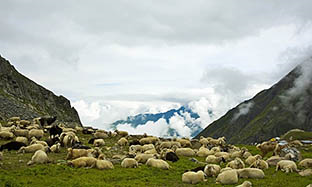.jpg)
Sheep and Lamb diarrhea: How we treat it?
When sheep and goats have stomach diseases their droppings usually become soft, watery and smelly. There are many conditions that cause diarrhoea. These include colibacillosis, paratyphoid, Johne's disease, Rift Valley fever (Slenkdalkoors), coccidiosis, worms and poisonous plants.
This condition is caused by a germ (bacteria). It usually affects lambs/kids under 2 weeks of age. This age group is usually affected because of one or more of the following reasons:
- Lambs/kids need to drink the first milk from their mothers, which is known as colostrum. This protects them to a certain extent from colibacillosis and a variety of other diseases. If lambs/kids do not drink this milk after they are born they are more likely to get sick.
- Paddocks or kraals are dirty and wet.
- Lambs/kids are already sick with another disease, which makes them more vulnerable to become infected with colibacillosis.
- Lambs/kids are placed under stress by moving them to another location (e.g. another paddock/kraal) or putting too many lambs/kids together.
The germ causing colibacillosis is present in the droppings of sick sheep and goats. When lambs/kids eat food or drink water contaminated with these droppings they get sick.
The animals are depressed and not eating. They have a watery, whitish-yellow or greyish diarrhoea that is known as "white scours". The umbilical cord is sometimes red and swollen. The back legs are dirty with droppings. Lambs/kids usually die as a result of dehydration.
Colibacillosis can be treated with antibiotics. It is important to give sick lambs/kids sufficient water and electrolytes to prevent them from dying of dehydration. Ewes and does can be vaccinated 6 to 8 weeks before birth to protect their lambs/kids.
This disease is caused by a germ (bacteria). It usually affects older lambs and 2- to 4-tooth sheep and goats (1 to 2 years of age). The reasons for this include one or more of the following:
- Stress caused by moving the sheep and goats, for example to a feedlot or an abattoir or keeping too many sheep and goats together.
- Sudden change in feed, e.g. they are usually put onto a high concentrate, low roughage feed when moved to a feedlot.
High numbers of Salmonella germs present in the environment, e.g. at the abattoir or feedlot.
They have a fever and do not eat. A watery green diarrhoea that is sometimes spotted with blood can be seen. They usually die within 7 days from dehydration or septicaemia. If they do not die within 7.
Sheep and goats have diarrhoea and become weak and dehydrated. In severe cases animals could die.
Gut is filled with a watery, foul-smelling liquid. Parts of the plant are sometimes found in the stomach.
Immediate treatment consists of giving enough clean drinking water. Giving activated charcoal sometimes also helps. If possible, take the animals to alternative grazing where poisonous plants do not occur.
Inspect your farm regularly for poisonous plants and remove them. Ensure that sheep and goats have enough food so that they need not eat the poisonous plants. Take special care when bringing new animals onto your farm, because they would not yet know to avoid poisonous plants and are most likely to be affected. Also take special care during early spring when some poisonous plants start to grow before green grass becomes available.
- Separate the sick sheep and goats from the healthy ones.
- If one or two are lying down, provide shade and fresh food and water.
- Try to give them activated charcoal and electrolyte solutions.
- Prevent blowfly strike by cleaning the back legs.
- Find out exactly what is making your sheep and goats sick so that you can give the correct treatment. You can do this by contacting your veterinarian for advice. You can also send in fresh droppings of both healthy and sick animals to a laboratory for testing.
- Electrolyte solutions are given to prevent dehydration and to give the sick animals energy. An example of an electrolyte solution that you can buy is lectade. You can make your own electrolyte solutions at home.
1. What can I give my goat to stop diarrhea?
To stop diarrhea in goats, it is crucial to provide them with plenty of clean drinking water to prevent dehydration. Administering electrolyte solutions can help maintain their energy levels and hydration status. Additionally, giving activated charcoal can sometimes assist in treating the condition. For more specific treatments, it's important to identify the cause of the diarrhea and administer appropriate medications. Treatment for diarrhea in goats often includes antibiotics if the cause is bacterial, such as in cases of colibacillosis or paratyphoid (salmonellosis).
2. What is the most common cause of diarrhea in goats?
The most common cause of diarrhea in goats is bacterial infections, such as colibacillosis and paratyphoid (salmonellosis). Colibacillosis typically affects lambs and kids under two weeks of age, often due to insufficient colostrum intake, dirty and wet environments, or stress. Paratyphoid affects older lambs and sheep and is often triggered by stress, sudden changes in diet, or high concentrations of Salmonella bacteria in the environment.
3. What medications are commonly used to treat diarrhea in goats?
The treatment for diarrhea in goats often involves the use of antibiotics to combat bacterial infections like colibacillosis and salmonellosis. In addition to antibiotics, ensuring that goats receive sufficient water and electrolytes is crucial to prevent dehydration. In some cases, administering activated charcoal can be beneficial. Vaccination of ewes and does 6 to 8 weeks before birth can also help protect lambs and kids from colibacillosis.
4. How long does it typically take for a goat to recover from diarrhea?
The recovery time for a goat suffering from diarrhea can vary depending on the severity of the condition and the effectiveness of the treatment. For bacterial infections like colibacillosis and salmonellosis, recovery can take about 7 days if treated promptly with antibiotics and supportive care, such as providing clean water and electrolytes. In severe cases, goats may succumb to dehydration or septicemia if not treated in time. Prompt and appropriate treatment for diarrhea in goats is essential for a swift recovery.


